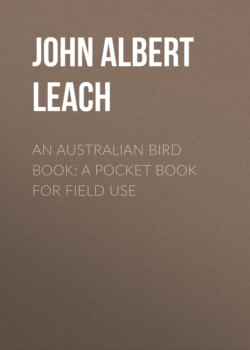Читать книгу An Australian Bird Book: A Pocket Book for Field Use - John Albert Leach - Страница 8
На сайте Литреса книга снята с продажи.
NOTES.
ОглавлениеWhere one number is placed over another at the left side of the page, the lower number denotes the number of species of that genus found in the world; the upper denotes the number of species found in Australia and Tasmania.
The number at the right side of the page is the length of the bird in inches (from the tip of bill to the tip of tail).
The families of birds known are numbered consecutively, thus, F. 11, F. 12, and so on. The number after a family name denotes the number of species recorded from Australia and Tasmania. The distribution of the species of each family amongst the six zoogeographical regions is shown thus:
F. 17. COLUMBIDAE (2), WOOD PIGEONS, Passenger-Pigeon, Rock-Dove, 119 sp.—41(40)A., 25(17)O., 18(10)P., 19(17)E., 4(0)Nc., 24(20)Nl.
This should read: Family number 17 of the world's birds, COLUMBIDAE (two of which are found in Australia and Tasmania) contains the Wood Pigeons, including the Passenger-Pigeon (of North America) and the Rock-Dove (of Europe). It comprises 119 species, of which 41 are found in the Australian Region, 40 of them being confined to this region; 25 are found in the Oriental Region, 17 being confined to it; 18 are found in the Palaearctic Region, 10 of which are not found outside the region; 19 have been recorded from the Ethiopian Region, 17 being peculiar to that region; 4 have been recorded from the Nearctic Region, none of which is restricted to the region; 24 have been recorded from the Neotropical Region, 20 being peculiar to it.
The name in black type is the name accepted by the Australasian Association for the Advancement of Science in 1898, and amended by the "names" sub-committee of the Royal Australasian Ornithologists' Union, 1911. This name should be used to denote the bird. Many local names are given, so that a person knowing a bird by one of these may discover its proper name.
A.—Australian Region (from Wallace's Line to Sandwich Islands and New Zealand, see map p. 10).
O.—Oriental (Indian) Region (India to Wallace's Line).
P.—Palaearctic Region (Europe, N.W. Africa, and Northern and Western Asia, except Arabia).
E.—Ethiopian Region (Arabia and Africa, except N.W.).
Nc.—Nearctic Region. ("The A.O.U. Check-List of North American Birds, 1910" has been followed in making this North America, less Mexico).
Nl.—Neotropical Region (South America, with Mexico).
A.O.U.—American Ornithologists' Union; R.A.O.U—Royal Australasian Ornithologists' Union.
A. denotes found throughout Australia; E.A. denotes found in Queensland, N.S.W., and Victoria; S.A. denotes South Australia; C.A. denotes Central Australia; W.A. denotes Western Australia; N. Ter.—Northern Territory; Mal.—Malaysia; Mol.—Molucca Is.; N. Cal.—New Caledonia; N. Heb.—New Hebrides; N.G.—New Guinea; N.Z.—New Zealand; Br.—British; T.—Tasmania.
Nom.—Nomadic; Mig.—Migratory; Part. Mig.—Partly Migratory; Stat.—Stationary; exc.—except; acc.—accidental.
C.—common; v.c.—very common; r.—rare; v.r.—very rare; u.—unlikely that the ordinary observer will see it.
* means see colored illustration.
f.—female; m.—male; f., sim.—f. is similar in color and size.
=vt. Eur. denotes that the Australian bird is closely similar in form, habits, &c., to the corresponding European bird.
=vt. cos. denotes that it is the equivalent or representative of a cosmopolitan group of birds.
1
4
6* King Quail (Chestnut-bellied, Least, Dwarf), reads "No. 6 (see colored illustration) is the King Quail, called also the Chestnut-bellied Quail, Least Quail, and Dwarf Quail. Four of this genus are known in the world, of which one is found in Australia."
(e) denotes that a name is used in error.
A Yellow-tailed Tit-Warbler is about 4 in. long; a White-eye, 4.5 in.; a Sparrow, 5 in.; a House-Swallow, 6.5 in.; a Sordid Wood-Swallow, 7 in.; a Black and White Fantail, 7.5 in.; a Starling, 8.5 in.; a Harmonious Shrike-Thrush, 9.5 in.; a Noisy Miner, 10 in.; a Magpie-Lark, 10.5 in.; a Butcher-Bird, 11 in.; a Pallid Cuckoo, 12 in.; a Rosella, 12.5 in.; a Galah, 14 in.; a Wattle-Bird, 14.5 in.; a Laughing Kingfisher, 17.5 in.; a White-backed Magpie, 18 in.; and a Crow, 20 in. (measured from the tip of tail to the tip of bill).
Don't try to judge a bird's length in inches.
Note one or two prominent markings, and the size of a bird; say, larger than a Starling, but smaller than a Magpie-Lark. Then get the length of these birds from the table above (8½ in. and 10½ in. respectively), and compare the description of each bird that comes between these lengths with the illustrations and the bird before you. The birds are approximately relative size on each block.
Use the index to find the page of a bird, then use the number, if asterisked, to find the bird in the colored plate index.
